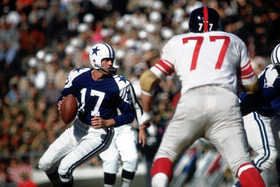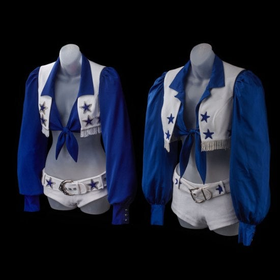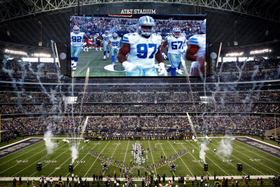
Growing up, I wasn't a fan of the Dallas Cowboys — not even a little bit. Watching my team, the San Francisco 49ers, get dismantled in the early 90s, and hearing about it from the Cowboys fans at school was nauseating. I wondered how other kids at school could back the team when they had never set foot in Dallas, let alone Texas.
For as long as I can remember, the Cowboys have always been one of the most popular teams in not just football, but sports, regardless of where their followers resided. Looking back, I realize that it wasn’t a personal tie to the organization or a hometown allegiance, but rather a commitment to, and support of, what the Cowboys stood for. Everyone knows about this team, and it's evident in their most recent valuation.
According to a Forbes's study on the NFL, the Dallas Cowboys have raked in $950 million in revenue and are worth around $5.5 billion. Their popularity and market share are reminiscent of other American brands, like Ralph Lauren or Ford, which are synonymous with classic and traditional values. It may seem that there's no correlation between each of these brands' success stories, but that's far from the case. All three brands built their success by understanding the value of crafting a brand. This has led to Ralph Lauren becoming America's designer, Ford becoming America's car, and the Dallas Cowboys becoming “America's Team.”
NFL Films was founded in 1962 by the father-son duo Ed and Steve Sabol and made myth-building the central vehicle of their business. From the beginning, the Sabols set out to make average football players into gridiron goliaths, similar to what Hercules and Achilles were to Greek mythology. As the profile of the players covered grew, so did the NFL as a whole. So when it came time to create the Dallas Cowboys highlight film for the 1978 season, NFL Films was well-versed in crafting a brand — elevating the team to hero-like status with classic storytelling.
NFL Films producer, Bob Ryan, is known as the person who coined the term "America's Team." In the highlight film, he described how the Cowboys epitomized the gold standard for the NFL and that their popularity among fans reflected that. Their success on the field (they were the first NFL team to reach five Super Bowls) resulted in more nationally televised games and exposure than any other team in the league.
In the uncertain times of the 70s, when confidence in the country was at an all-time low, the team embodied traditional American values and principles of the past. They created a sense of national pride and became something that others aspire to be: winners. The Cowboys successfully leveraged this term to build their story — crafting a brand through innovation, financial investment in customer experience, and ultimately success on the field.
There's a lot that goes into crafting a brand; it's not merely one action or short sequence of events that lead to a carefully constructed brand narrative. It takes years of smart planning and committed execution to create a brand that wins the hearts and minds of fans. Through a series of fortuitous decisions and savvy moves, the Dallas Cowboys leveraged the "America's Team" moniker to become one of the premier sports franchises in the world.
Tex Schramm, the Dallas Cowboys' first president and general manager, knew a thing or two about crafting a brand. During his time with the Los Angeles Rams, he was astute enough to spot talent that would help elevate the team's standing with the public. Most notably, Tex hired Pete Rozelle, the future NFL commissioner and Hall of Famer, as his public relations director. Once Tex was appointed by Dallas, he tapped into that branding know-how and used it in other facets.
The team's owners initially settled on the name “the Dallas Steers," but at Tex's urging, the ownership group relented and changed the name. The ownership group went back and forth with other iterations, but ultimately settled on the "Cowboys." The simplicity of the name aligned perfectly with Dallas’s story of the classic American archetype: challenging hardships, overcoming obstacles, and maintaining independence. These core values have also resonated with the team's fans, dating as far back as when "America's Team" was first introduced.

Key takeaway: The name of a brand will significantly impact its success. When coming up with potential names, brands need to ensure that what they decide to call themselves aligns with their core values, reflects a narrative consistent with their brand, and speaks to their target audiences.
People have always wanted to be associated with winners, and for the Cowboys, their success on the field has helped further the narrative that they're America's Team. Despite it being over 20 years since they won a Super Bowl (but who's counting?), the Cowboys do have an extensive record of success. They've won eight NFC championship games (more than any other team) and five Super Bowls — organizational achievements that shouldn't be taken lightly.
Even with their success on the field, it was really the personalities of the players that elevated their brand to the next level. In the 70s, Roger Staubach, affectionately nicknamed Captain America, was the standard-bearer of American masculinity for both men and children alike. In the 90s, the colorful personalities of Hall of Famers Deion Sanders and Michael Irvin embodied the shift towards individual expression in professional sports — inspiring future football players in the process. The players' brands actually fed into the team's brand, giving fans the chance to gravitate towards players they connected with. This is similar to how legions of young girls in the 90s had their favorite Spice Girl.
Because of their players, the Dallas Cowboys were able to form a strong emotional bond with fans, a crucial part of crafting a brand.
Key takeaway: Embrace the differences (skill-sets, personalities, and tastes) of your team and find ways to showcase them. Doing so makes brands more dynamic and builds brand affinity with audiences.

When it came time for the 1970 season, Tex was able to get internal buy-in to reintroduce the Dallas Cowboys cheerleaders in a new vision by pitching it as a way to boost attendance and fanfare around the team. His assessment wasn't wrong. As the popularity of the team grew, so did the cheerleaders. By 1977, the cheerleading squad had a famous poster produced and were featured in Esquire magazine.
Key takeaway: Don't be afraid of a radical idea. Finding new, innovative subsets to your brand helps you connect with target audiences and goes a long way in crafting a narrative.
Everything is bigger in Texas, including the team's wallet. The Cowboys have never been shy about spending money, whether that's for training equipment, players, or even a stadium. The team's brand symbolizes being the best of the best, so investments into the team need to reflect that.
The current owner, Jerry Jones, opened AT&T Stadium back in 2009 and spent $1.15 billion to create the biggest spectacle in American sports. Affectionately called "Jerry's World," the stadium boasts every amenity known to man, including a video display board that was the largest HD TV screen in the world at the time of its installation. That type of spending lends to the on-the-field product.

Jerry Jones has opened up his pocketbook to acquire the best talent available. In response to their defeat to the 49ers in the 1994 NFC championship game, Jerry Jones made Deion Sanders the second-highest-paid Cowboy with a $30 million contract. That may not sound like much now, but at the time, it was a significant number. That commitment to providing the best product hasn't changed, with the Cowboys locking down their star running back to a $90 million contract, making him one of the highest-paid running backs in the NFL.
Key takeaway: In order to see real results, investments need to be made. While they don’t have to be extravagant expenses, crafting a brand doesn't come cheap, so there is a need to put real resources behind products and customer experiences.
The Dallas Cowboys didn't become America's Team overnight. Sure there were a few lucky breaks (the Dallas Steers, anyone?), but the likes of Tex Schramm and Jerry Jones capitalized on nearly every opportunity to advance the Cowboys' brand and ensure it matched the pre-existing narrative.
For those interested in crafting a memorable brand similar to the Dallas Cowboys, check out these three ways to increase brand awareness:
Brand awareness is critical to your brand's success. Find out the three things you can do to increase brand awareness.
And if you're not sure where to start with building brand awareness, AdRoll can help to create awareness with the right shoppers, in the right place, at the right time, to get new high-quality traffic to your site.
Last updated on April 14th, 2022.